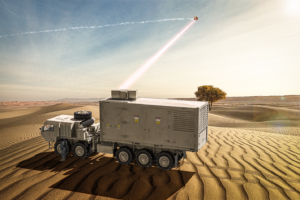The Missile Defense Agency (MDA) awarded Lockheed Martin [LMT] a $2 million contract on Sept. 16 to investigate the utility of laser weapon technology for missile defense operations.
The award notice said under this contract the company “will explore whether laser weapon systems technologies can be effectively integrated into the Missile Defense System.”
The announcement called this project Directed Energy Lethality for Fast Threats (DELFT). Work will occur in Sunnyvale, Calif. And is expected to last until September 2023.
MDA said the contract was competitively procured under MDA’s Innovation, Science, & Technology Broad Agency Announcement (BAA), but did not disclose if there were any other offerors.
According to the original solicitation, updated in June, MDA was looking for contractors to conduct a study of diode-pumped alkali laser (DPAL) technology and its application to the Missile Defense System, “ to include industry recommendations on platform and mission, as well as industry determination of the necessary performance of DPAL in order to be relevant to the MDS.”
The notice said a technical data package on current DPAL technology was available to offerors with valid security clearances.
The agency anticipated multiple awards would result from a previously solicited Innovation, Science and Technology (IS&T) BAA, with awards unlikely to exceed $1 million each.

The BAA aimed to identify and develop “innovative concepts across a broad spectrum of science and engineering disciplines, to include disruptive technologies, that stimulate technology innovation and exploit breakthroughs in science to offer robust technology improvements to the Missile Defense System (MDS).”
One of the suggested research areas under the BAA was directed energy systems.
This “includes, but is not limited to compact, reliable, and efficient high-energy (> hundreds of kilowatt-hours) lasers; high power microwave (HPM) systems; related directed energy components; and directed energy lethality/effects on target (Laser and/or HPM with the target in the hypersonic regime).”
The notice background documents said MDA is specifically interested in “diode-pumped fiber, solid state, gas, and liquid phase lasers (continuous wave or pulsed); and laser arrays, including line stable diode arrays and high power, high efficiency, narrow linewidth arrays.”

For microwave systems, the agency was also interested in “high power amplifier technologies, frequency/waveform flexibility, antenna gain and efficiency improvements, and concepts for effective combination techniques for multiple directed energy weapons on a single overlapping aim point.”
Lockheed Martin has significant experience in laser weapons. This award came the same week the company delivered a 300-kilowatt class laser capability to the Defense Department for the Office Under Secretary of Defense for Research and Engineering’s (OUSD R&E) High Energy Laser Scaling Initiative (HELSI) program (Defense Daily, Sept. 15).
That laser is due to be used for the Army’s Indirect Fire Protection Capability-High Energy Laser (IFPC-HEL) program.
Last month, the company also announced it delivered the 60+kW-class high energy laser with integrated optical-dazzler and surveillance (HELIOS) system, set to be first installed on the Arleigh Burke-class destroyer USS Preble (DDG-88) during an Aegis modernization availability this year (Defense Daily, Aug. 18).
In a January earnings call, the company’s chairman, president and CEO, James Taiclet, said it spent $1.5 billion on independent research and development, including directed energy (Defense Daily, Jan. 25).
